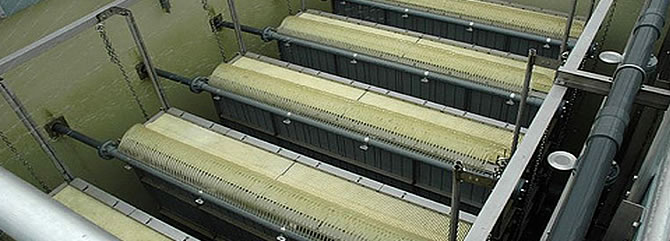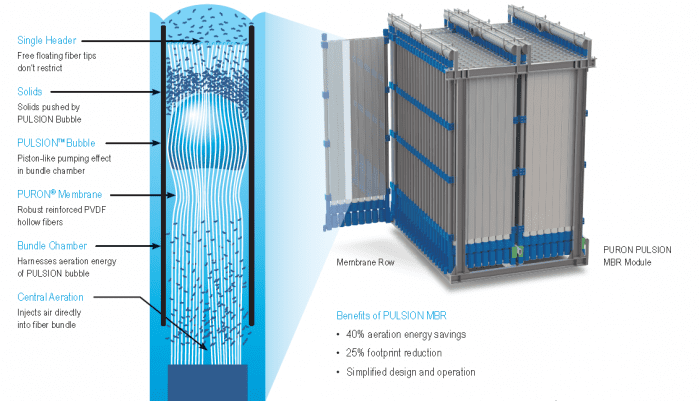Why Membrane Bioreactor is the Future of Wastewater Treatment in Industries
Why Membrane Bioreactor is the Future of Wastewater Treatment in Industries
Blog Article
Just How Membrane Bioreactors Are Changing Water Purification Equipments
The emergence of membrane bioreactors (MBRs) represents a significant advancement in the field of water filtration, combining organic therapy procedures with sophisticated membrane layer filtering innovations. As worldwide water shortage increases, the function of MBRs in assisting in drinkable water reuse and sustainable water management becomes significantly essential.
Review of Membrane Layer Bioreactors
Membrane layer bioreactors (MBRs) represent a significant innovation in water filtration innovation, as they combine organic therapy processes with membrane purification. This combination enhances the efficiency of wastewater therapy by using microorganisms to degrade natural contaminants while at the same time using semi-permeable membrane layers to separate cured water from suspended solids and pathogens.
The MBR system normally consists of an organic reactor where the microbial population metabolizes impurities, followed by a membrane layer filtering unit that maintains biomass and allows just clean water to travel through. This dual capability leads to greater effluent high quality contrasted to traditional therapy techniques. MBRs can be run in both batch and continual flow modes, offering flexibility in layout and application.
Additionally, MBRs are identified by their compact impact, making them ideal for metropolitan settings with room restraints. Membrane Bioreactor. They also allow the healing of water for reuse, therefore adding to water sustainability efforts. While MBR modern technology has gotten popularity in local and commercial applications, its functional intricacies and energy demands demand careful consideration throughout execution. In general, MBRs go to the center of improving water treatment effectiveness and top quality, showcasing the potential for innovative options in ecological monitoring.
Advantages of MBR Technology
The integration of organic treatment with membrane purification supplies many advantages for water filtration processes. Among the key advantages of Membrane layer Bioreactor (MBR) modern technology is its ability to successfully eliminate both inorganic and natural pollutants, resulting in top quality effluent. The membranes serve as a physical obstacle, protecting against suspended solids and pathogens from going through, which boosts the overall safety and security and reliability of treated water.
Furthermore, MBR systems call for a smaller footprint compared to traditional therapy approaches, enabling extra efficient space application. This compact style is specifically advantageous in city settings where land is restricted. MBRs likewise demonstrate operational flexibility, accommodating differing influent qualities and flow rates without considerable performance degradation.
Moreover, the process provides improved nutrient removal abilities, particularly for nitrogen and phosphorus, which are vital for protecting against eutrophication in obtaining waters. The lowered sludge manufacturing related to MBR innovation likewise translates to lower disposal prices, making it a cost-effective solution over time - Membrane Bioreactor. On the whole, the benefits of MBR innovation position it as a leading selection for cutting-edge and sustainable water filtration systems, dealing with both environmental and financial worries
Applications in Water Purification
Applications of Membrane Layer Bioreactor (MBR) innovation in water purification are impactful and varied, addressing numerous treatment needs throughout multiple sectors. MBRs efficiently integrate organic treatment procedures with membrane filtration, making them excellent for local wastewater therapy, commercial effluent administration, and also drinkable water reuse campaigns.
In municipal settings, MBRs are progressively utilized to boost the top quality of treated wastewater, permitting compliance with strict discharge guidelines and promoting the recycling of water for irrigation and non-potable uses. Their compact design also makes them suitable for urban atmospheres where area is limited.
Industrially, MBR innovation is used to treat process water and wastewater, especially in industries such as food and beverage, pharmaceuticals, and textiles. By efficiently removing contaminants and suspended solids, MBRs aid sectors decrease ecological influences while recouping useful resources from wastewater streams.
Furthermore, MBRs are acquiring traction in decentralized water therapy applications, where small systems can be deployed in remote areas or developing areas. This flexibility makes it possible for areas to accomplish sustainable water monitoring remedies, improving access to clean water while lowering dependence on conventional treatment approaches.
Situation Studies and Success Stories

In an read more additional instance, a fabric production facility in Bangladesh adopted MBR technology to address its wastewater challenges. The system decreased chemical oxygen demand (COD) levels from 1,200 mg/L to less than 100 mg/L, thus meeting regulatory standards and considerably reducing environmental impact.
The University of Cape Town's MBR installment has actually verified efficient in treating greywater for non-potable reuse on school. This project not only preserves safe and clean water yet likewise works as an academic model for lasting techniques.
In addition, a fish and shellfish processing plant in Norway utilized MBR modern technology to deal with effluents consisting of high levels of natural issue, accomplishing over 90% pollutant elimination. These situation studies underscore MBR modern technology's adaptability and its important role in boosting water high quality throughout varied applications.
Future of Water Treatment Solutions
As Home Page international water shortage and pollution obstacles heighten, innovative water therapy services are coming to be progressively necessary to make certain sustainable accessibility to clean water. The future of water therapy depends on the combination of advanced innovations that enhance the effectiveness and effectiveness of purification procedures. Click Here Membrane bioreactors (MBRs) go to the forefront of this development, incorporating biological therapy with membrane layer filtering to generate top quality effluent ideal for numerous applications.

Arising patterns such as resource recuperation from wastewater, consisting of nutrients and energy, will certainly better change treatment centers right into environment-friendly hubs. Furthermore, innovations in nanotechnology and membrane layer materials assure enhanced performance and long life of filtering systems.

Verdict
Their role in safe and clean water reuse and lasting water management highlights their relevance in attending to global water deficiency difficulties. Proceeded research study and growth will further boost the efficiency and adoption of MBR innovation, guaranteeing a resistant future for water treatment options.
The development of membrane layer bioreactors (MBRs) represents a considerable advancement in the field of water filtration, merging biological therapy processes with innovative membrane layer filtration innovations. As international water shortage intensifies, the function of MBRs in promoting potable water reuse and sustainable water monitoring comes to be increasingly important. They additionally enable the healing of water for reuse, hence adding to water sustainability initiatives.As global water shortage and contamination obstacles intensify, ingenious water treatment options are coming to be significantly essential to guarantee sustainable access to clean water. Their function in drinkable water reuse and lasting water administration highlights their value in resolving international water shortage difficulties.
Report this page